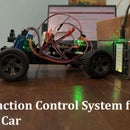Introduction: Arduino Music: Chord Detector
This Tutorial is an extension of the previous instructable on Arduino Note detector. Here modifications are made to make use of calculated notes to detect the chord. A demonstration is shown in the attached video.
This program can give around 6-7 samples/second on Arduino Nano.
Attachments
Supplies
Arduino Nano/Uno or better
Microphone module for Arduino
Step 1: Working of Code
Complete working from sampling audio data to extracting top frequency is the same as the previous program on Music Note detection:
1. Data acquisition:
- this section takes 128 samples from audio data, the separation between two samples (sampling frequency) depending on the frequency of interest. In this case, we are using spacing between two samples is used to apply Hann window function as well as amplitude/RMS calculation. This code also does rough zeroing by subtracting 500 from analogread value. This value can be changed if required.
For a typical case, this values work well. Further, some delay needs to be added to have a sampling frequency of around 1200Hz. in the case of 1200Hz sampling frequency max of 600 HZ frequency can be detected.
for(int i=0;i<128;i++)
{ a=analogRead(Mic_pin)-500; //rough zero shift sum1=sum1+a; //to average value sum2=sum2+a*a; // to RMS value a=a*(sin(i*3.14/128)*sin(i*3.14/128)); // Hann window in[i]=4*a; // scaling for float to int conversion delayMicroseconds(195); // based on operation frequency range }
2. FFT: Once data is ready, FFT is performed using EasyFFT. This EasyFFT function is modified to fix FFT for 128 samples. The code is also modified to reduce memory consumption. The original EasyFFT function designed to have up to 1028 samples (with the compatible board), while we only need 128 samples. this code reduces memory consumption of around 20% compared to original EasyFFT function. Once FFT is done, the code returns the top 8 most dominant frequency peaks for further analysis. This frequency are arranged in descending order of amplitude.
3. For every peak, the code detects possible notes associate with it. this code only scans up to 1200 Hz. It is not necessary to have note the same as the frequency with max amplitude. All frequencies are mapped between 0 to 255, here the first octave is detected, for example, 65.4 Hz to 130.8 represents one octave, 130.8 Hz to 261.6 Hz represents another. For every octave, frequencies are mapped from 0 to 255. here mapping starting from C to C'.
if(f_peaks[i]>1040){f_peaks[i]=0;}
if(f_peaks[i]>=65.4 && f_peaks[i]<=130.8) {f_peaks[i]=255*((f_peaks[i]/65.4)-1);}
if(f_peaks[i]>=130.8 && f_peaks[i]<=261.6) {f_peaks[i]=255*((f_peaks[i]/130.8)-1);}
if(f_peaks[i]>=261.6 && f_peaks[i]<=523.25){f_peaks[i]=255*((f_peaks[i]/261.6)-1);}
if(f_peaks[i]>=523.25 && f_peaks[i]<=1046) {f_peaks[i]=255*((f_peaks[i]/523.25)-1);}
if(f_peaks[i]>=1046 && f_peaks[i]<=2093) {f_peaks[i]=255*((f_peaks[i]/1046)-1);}NoteV array values are used to assign the note to the detected frequencies.
byte NoteV[13]={8,23,40,57,76,96,116,138,162,187,213,241,255};4. chord detection:
for (int i=0;i<12;i++)
{ in[20+i]=in[i]*in[i+4]*in[i+7]; in[32+i]=in[i]*in[i+3]*in[i+7]; //all chord check }
this section checks for all chords by multiplying note values with each other as per major and minor code combination. this section also makes use of same Input array for data storage.
further, the chord with the max possibility (max multiplication) selected to display.
Step 2: Application
Using the code is straight forward, however, there are also multiple limitations that need to be kept in mind while it. The code can be copied as it is used for note detection. The below points need to be considered while using it.
1. Pin Assignment: Based on the attached Pin assignment needs to be modified. For my experiment, I kept it to Analog pin 7,
void setup() {
Serial.begin(250000);
Mic_pin = A7;
}2. Microphone sensitivity: Microphone sensitivity needs to be modified such waveform can be generated with good amplitude. Mostly, the Microphone module comes with a sensitivity setting. appropriate sensitivity to be selected such that signal is neither too small and also not clips off due to higher amplitude.
3. Amplitude threshold: This code activates only if the signal amplitude if high enough. this setting needs to be set manually by the user. this value depends upon microphone sensitivity as well as application.
if(sum2-sum1>5){
.
.in the above code, sum2 gives RMS value while sum 1 gives mean value. so the difference between these two values gives the amplitude of the sound signal. in my case, it works properly with an amplitude value of around 5.
4. By default, this code will print the detected note. however, if you are planning to use the note for some other purpose, the directly assigned number should be used. for example C=0;C#=1, D=2, D#=3 and onward.
5. If instrument have higher frequency, the code may give false output. the maximum frequency is limited by the sampling frequency. so you may play around below delay values to get optimum output. in below code delay of 195 microseconds. which may be tweaked to get optimum output. This will affect the overall execution time.
{ a=analogRead(Mic_pin)-500; //rough zero shift
sum1=sum1+a; //to average value
sum2=sum2+a*a; // to RMS value
a=a*(sin(i*3.14/128)*sin(i*3.14/128)); // Hann window
in[i]=4*a; // scaling for float to int conversion
delayMicroseconds(195); // based on operation frequency range
}6. this code will only work till 2000Hz frequency. by eliminating the delay between sampling around 3-4 kHz of sampling frequencies can be obtained.
Precautions:
- As mentioned in the EasyFFT tutorial, the FFT eats up a huge amount of memory of Arduino. So if you have a program that needs to store some values it is recommended to use a board with higher memory.
- This code may work well for one instrument/vocalist and bad for another. Real-time Accurate detection is not possible due to computational limitations.
Step 3: Summery
The detection using this code is quite accurate for piano sound for frequency under 1100Hz. for applications that require frequency values higher than 1100Hz would required multiple modifications in the code.
Hope this code will be useful for your project. so if you have any suggestions on queries do let me know over a massage or in comment box.

Participated in the
Audio Challenge 2020














